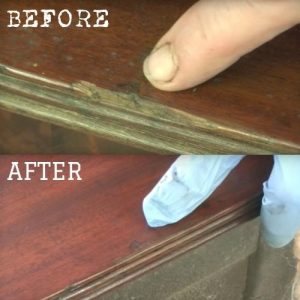 So that chair you love is broken, or maybe someone in your place of business cracked some of your wooden furniture. The question that immediately arises after the initial shock is: “shoot, how am I supposed to fix this?” Before you start driving nails into your furniture or before you bust out the handy duct tape, maybe consider taking a look at a wood epoxy putty repair stick.
So that chair you love is broken, or maybe someone in your place of business cracked some of your wooden furniture. The question that immediately arises after the initial shock is: “shoot, how am I supposed to fix this?” Before you start driving nails into your furniture or before you bust out the handy duct tape, maybe consider taking a look at a wood epoxy putty repair stick.
When do you need wood epoxy putty stick for furniture repair?
First, we should probably explore the best times to use a wood epoxy stick during furniture repair. Wood epoxy sticks are great for dry rot repair, rot repair in general, breaks, cuts and scrapes. You can use it to fill nail holes, stripped screw holes, scratches, gouges, cracks, dry rot and knot holes. It also repairs molding and frames on furniture. If your furniture takes moving or transportation damage, epoxy putty will work for it too. If you have a furniture restoration business or furniture restoration company, wood epoxy putty stick would be a great purchase. The best part about wood epoxy putty is that can be tapped, screwed, drilled, sanded, sawed, filed, painted and most importantly, stained. That way you know that your furniture will always be one uniform color. But let’s pretend you’ve never heard of wood epoxy putty for a moment. Next, we should probably determine how to use a wood epoxy putty stick for furniture repair.
How would one use wood epoxy putty stick repair furniture?
Check out this video to show a minimally invasive repair with wood epoxy putty for an antique furniture restoration. For this task, you’ll need a good wood epoxy putty stick, some sandpaper, some tape, some sort of blade, steel wool, shellac, some stain that’s the same color as your furniture and some water. Let’s go through them, shall we?
-
- Locate the crack, split or nail/screw hole in your furniture.
-
- Place tape underneath the offending area, so as not to spill epoxy all over your table. Think like you’re painting, when you tape areas you don’t want painted.
-
- Cut off a piece of epoxy. As much as you may need to fill the break in your wood.
-
- Knead the epoxy together until the hardener and the epoxy have mixed, or it’s all one uniform color.
-
- Place the ready epoxy on the break.
-
- Wait about five minutes for it to harden a little bit. Press and form smoothly until the epoxy is in the groove. Using water and a straight knife works best.
-
- Cut off all excess epoxy that may be hanging off the repair.
-
- Get your steel wool and water. Gently smooth the epoxy out even more so it’s even with your piece of furniture. If need be, you can use sandpaper to really smooth out your epoxy, but careful not to hit the surrounding wood.
-
- Shellac the epoxy and the area around it. Let it dry overnight.
-
- Stain the fixed area until it’s the same color as the rest of the furniture.
- Consider throwing some shellac on the rest of the furniture to make it really shine.

Now that you know how to fix furniture with a wood epoxy putty Stick, which one should you use? With some many different products on the market, which one is the best?
Brofix wood epoxy putty repair stick
Introducing the Brofix wood epoxy putty repair stick by Brodi, the best possible wood epoxy stick on the market for any kind of wood repair. This hand mixable epoxy putty is great stuff for furniture repair has some great statistics to boot. Let’s explore them, shall we see here?
-
- Amazing for furniture restoration, furniture repair.
-
- Great for dry rot repair, also solvents will not rot
-
- This product is very versatile, and can be used in exterior or interior applications.
-
- Contains no solvents, no odour.
-
- Great for prototyping and fabricating small parts.
-
- It’s the best on the market to be tapped, screwed, drilled, sanded, sawed, filed, stained or painted
-
- Lap Shear Strength range from 350 to 900m p.s.i.
-
- Compressive Strength range from 10,000 to 12,000 p.s.i.
-
- Electrical resistance 30,000 megohms
-
- Dielectric strength 300 volts/mil
-
- Upper Temperature Limit 250°F continuous, 300°F intermittent
-
- Chemical resistant to hydrocarbons, ketones, alcohols, esters, halocarbons, aqueous salt solutions and dilute acids and bases
-
- Non-flammable and releases no noxious fumes
- Will not shrink, crack, rot or pull away.
There you have it, folks. Now you’re an expert on furniture repair with a wood epoxy repair putty. Remember, when your precious furniture accidentally breaks, trust the Brofix by Brodi. It won’t let you down.


